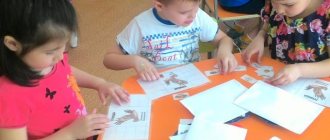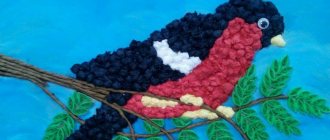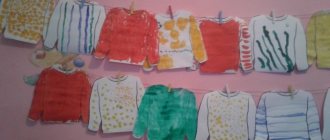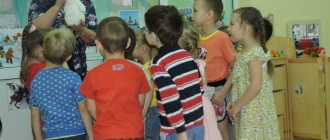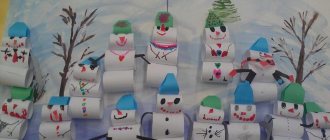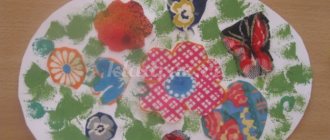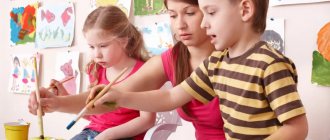Educational conversation “What kinds of insects are there?”
Educational conversation in the senior group
“What kinds of insects are there?”
Target:
systematize children’s ideas about the diversity of insects; consolidate knowledge about the general characteristics of insects; learn to establish connections between the features of the external structure and the method of movement, between appearance and the method of protection from enemies; clarify the habitats of insects; develop children’s cognitive and creative abilities, logical and spatial thinking, speech, fine motor skills; cultivate interest in insects and respect for them.
Developmental environment:
pictures and illustrations depicting insects, a visual aid “Insects”, an audio recording “The Dance of the Butterflies” by M. Krasev; book about nature “Miracle in the palm of your hand”, graphic model of an insect, plasticine.
PROGRESS OF THE CONVERSATION
Before the start of the lesson, children look at the visual aid “Insects”, flashcards and illustrations with insects.
— Today we are going to visit our six-legged friends. Who do you think we will talk about? (about insects)
- Right! Guys, by what main signs do we recognize insects? ( All insects have six legs. The body consists of three parts: head, middle part and abdomen)
-What else do insects have? (There are two antennae on the head, some have a proboscis and wings)
— Why do insects need a proboscis and wings?
(They feed with the help of a proboscis; wings are needed to move)
- Right! Many insects fly. Some fly very fast: a dragonfly, for example, can reach speeds of up to 40 km per hour. Other insects walk and jump. Can you name me such insects?
(Beetles that have no wings walk. A grasshopper jumps)
- Indeed, the grasshopper is a good jumper. He can jump a distance of 20 times his body length. And if he releases his wings, he will fly away, gliding, even further.
— Guys, what do insects eat? (Flower nectar, leaves)
— All insects feed differently. Some eat plants. These include grasshoppers. With their jaws, like nippers, they bite off pieces of grass. Butterflies and moths feed on flower nectar using a special proboscis. It spins like a squeaky toy. When the insect is not eating, the proboscis curls into a spiral. The mosquito feeds on plant sap and sweet nectar. And his female feeds on blood. She pierces the skin with her proboscis, like a syringe, and sucks blood. There are also predators among insects. This is a dragonfly - it feeds on flies and mosquitoes. moths. Some ants eat grass seeds, midges, and worms. And the ladybug feeds on the smallest living creatures - aphids. Guys, why are ladybugs called that (the story is accompanied by a demonstration of illustrations)
- Because they secrete “milk”, but not white one. and poisonous yellow, which appears on the bends of the paws in times of danger. In fact, it is blood, acrid and smelling unpleasant. Therefore, neither birds nor lizards eat cows. They can also be called migratory beetles. It turns out that at the end of summer and autumn, cows fly for the winter. And in the spring and early summer they return. But not all cows fly away. Many of them, like other beetles, hide in cracks, in the crevices of tree bark, and in last year’s grass. Therefore, if you burn last year’s grass, you can also burn insects. They must be treated with care and the grass in gardens and orchards must not be burned.
PHYSMINUTE
Children move smoothly to the music “Butterfly Dance”.
D/I “WHO LIVES WHERE”.
Cards with images of insects are laid out in front of you. You must take a card and place it on the picture that corresponds to the habitat of this insect. Children lay out the cards and comment on their choices.
— How does coloring help insects?
Indeed, the color of insects often depends on their habitat. This helps them escape from enemies. Some, thanks to coloring, become invisible. So the thorn bug looks like a thorn growing on a branch. Some butterflies, when sitting quietly, resemble a leaf. Some are invisible on tree bark. The flower mantis is similar to the flower on which it sits. (the story is accompanied by the display of corresponding illustrations) Other insects have such bright colors that enemies do not risk approaching them. Why do you think? (children's answers)
— Insects colored in red-black, yellow and black tones are usually unpleasant to the taste, and birds do not touch them. There are insects, the bombardier beetle, which release a stream of caustic chemicals with a pungent odor at the moment of danger. While the enemy comes to his senses, the beetle runs away.
— Guys, are there many or few insects on earth? (children's answers) What would happen if there were no insects? (children's answers)
Let's play the game "GOOD - BAD".
Are many different insects good or bad? (children's answers)
What else is good? (interesting to watch, beautiful, food for others, etc.)
What is wrong? (can sting, interfere with rest, etc.)
RESULT.
Who did we talk about today? What interesting things did you learn? Children choose to sculpt an insect.
Abstract of educational activities for cognitive development in the middle group on the topic: Insects
Abstract of educational activities on cognitive development (ecology) in the middle group on the topic “In the Land of Insects”
Goal: formation of spatial, visual representation and consolidation of knowledge about insects. Objectives: Educational: To clarify children’s knowledge about insects, their characteristic features, adaptability to living conditions; learn to express their movements with facial expressions, gestures and plasticity. Developmental: Development of attention. Act according to the algorithm based on the diagram. Act according to verbal instructions; Educational: to cultivate a caring attitude towards insects, a love of nature. Equipment: A jar with a bug, a projector, a presentation about insects, a flower with a butterfly, a TIKO “Fantaser” construction set - 1 set for two children, individual cards - diagrams of plane figures: Dragonflies and butterflies, an envelope with coloring pages depicting Luntik. Educator: Stand next to each other and smile at each other. Guys, let's stand in a circle and share our good mood with each other. I will smile and pass on my smile... (I say the name of the child standing on the right), he will pass on his smile to the next one. The smile should come back to me. (Children take turns passing smiles to each other.) (Luntik enters, holding a jar with a bug in his hands). Luntik : Hello! You recognized me. I'm Luntik. I live on the moon. You know, such an interesting creature landed on the moon. We don't have those on the moon. Who is this? When I was on earth, I saw something like this. Maybe he lives somewhere with you? Children: this is... Educator : Luntik, how good it is that you came to us. Well, we’re just heading to the land of “Insects”. If you are interested, stay with us and give me the bug, it will sit in our garden for now, and then we will release it. Well, Luntik, will you stay? Luntik: Of course, I’ll stay. Educator : Well, then guys, let’s say the magic words and go to the land of “Insects” “One, two, three - turn around yourself, and find yourself in the land of Insects” Children: (together with the teacher and Luntik, the children repeat the magic words and end up to the land of “Insects”) Educator : Guys, look at what a beautiful clearing is in front of us, let’s sit down on the stumps and tell our guest a little about insects. (pictures of insects appear on the screen) Educator: Now let's look at the screen. And you Luntik, look carefully, and the guys will tell you everything. Educator: Guys, look, most insects have wings. Tell me, please, why do insects have wings? Children: To fly from one place to another. Educator: Yes, they move more with the help of their wings, but they also have legs. Guys, please tell me what insects need to live? Children: They need air, water, sun, grass, flowers.... Educator: Luntik, tell me, are there conditions for insects to live on the moon? Luntik: No, that’s why I came to you. Educator: Guys, can you see insects on the water? Children: Yes, yes. A dragonfly flies near bodies of water. Mosquitoes, midges. Educator: how amazing and diverse insects are. Tell me, what harmful insects do you know? Children: For example, a fly, a mosquito. Educator: Why are flies harmful? Children: Flies carry infections. Mosquitoes bite people. Educator : At the same time, birds feed on flies. Who eats mosquitoes? Children: Frogs. Educator : Why can a butterfly be confused with a flower? Children: She is just as beautiful, colorful. Educator: Guys, tell me, is it possible to touch insects and bring them home? Children: No Teacher : Why? Children: They can bite, sting. They can't live at home. Educator: insects need to be protected. We can hurt them, you and I are so big, and they are small. Luntik: Oh, oh, who’s that flying and bothering me, I’m afraid! Educator: Luntik, don’t be afraid. Guys, look who flew to our clearing? Children: This is a dragonfly. Educator: Probably the dragonfly flew to us and wants to play with us. Well, let's play with the dragonfly? Children: Yes. Physical exercise. “Dragonfly” Here is a dragonfly flying (children imitate the flight of a dragonfly) Like pea eyes, (depict the large eyes of a dragonfly) And itself is like a helicopter, (rotation) Left, right, back, forward (tilts). Luntik: I wonder why the dragonfly flies alone? Does she have no friends? Educator: Don’t be discouraged Luntik, now our children will make girlfriends out of the TIKO construction set for the dragonfly and she will no longer be alone. (in front of the children there is a diagram of an image of a plane dragonfly and a “TIKO” fantasy designer). Educator: Guys, tell me what parts from the designer you will use when constructing a dragonfly. Children: Pentagon, squares, rectangles, triangle, elongated triangles. Scheme: Dragonfly Educator: Well, guys, sit down at the table. On the table is a construction set and a diagram of a dragonfly. Get to work, and Luntik and I will see what you can come up with. (while the children are constructing dragonflies, Luntik hides behind a bush) Educator: You guys are great, what beautiful dragonflies you have turned out to be. Let's place your dragonflies in our clearing, and the dragonfly will not be sad. (the children, together with the teacher, took the dragonflies to a clearing, also made from a “TIKO” construction set.) Educator : Guys, where is our guest? Nobody sees him? Luntik: I'm here, I'm here! Guys, look what I found? (Luntik comes out from behind a bush, he has a flower in his hand, and a butterfly is sitting on the flower) Luntik: What kind of animal is this? I have never seen such beauty before! Children: This is not a beast. Educator : Children, who are they? Children: This insect is a butterfly. Luntik: I don’t have such beautiful insects on the moon, but I really wish there were. (Luntik got upset) Educator: Luntik, don’t be upset. Our children love to design and now they will give you a gift, they will make butterflies from the TIKO construction set, and you can take them with you to the moon and admire them at home. Educator : Well, guys, sit down at the table. On the table is a construction kit and a diagram of a butterfly, which we will give to our guest. Educator: Guys, but before you start work, tell me what parts from the designer you will use when constructing the butterfly. Children: Pentagons, hexagons, squares, rectangles, triangles. Educator : Well, guys, start designing. (while the guys are constructing, Luntik is watching them). Scheme: Butterfly Educator: Luntik, look how well done the guys are, what beautiful butterflies they have made. Luntik: Very beautiful butterflies. Educator : What great kids, and you are Luntik. Our journey is coming to an end. We really hope that Luntik really enjoyed our trip and that he will come to visit us more than once, but we need to return to the Kindergarten. And we will leave Luntik in the land of “Insects” in a magical clearing. Let's say goodbye to our guest Children: Goodbye Luntik. Luntik: Goodbye guys. Educator: And in order to return, we need to say the magic words “Turn around yourself, 1, 2, 3 - and you will find yourself in Kindergarten!” So we returned to our favorite kindergarten. Children, tell me, did you like our trip? Children : Yes. Educator: Guys, tell us who came to visit us? What did Luntik bring? Where did we go? Did you like the land of “Insects”? Who were they talking about? And what insects did we talk to you about today? Children, what did we design today, and from whom? What parts did you use? Shall we go traveling again? Educator: Guys, look what Luntik left us. Envelope. Let's see what's there? And there are coloring pages with a picture of Luntik, what a wonderful gift our guest left us.
We recommend watching:
Summary of a lesson on application in the middle group. Snowman Poems about insects for children 3-4 years old Summary of a lesson in kindergarten on the topic “Insects”. Junior group A story about a grasshopper for preschool children
Similar articles:
Coloring pictures for children 4-5 years old on the theme “Insects”
Conversation with children about insects in the preparatory group
About a butterfly for children 6-7 years old
About ladybug for 1st grade
Talk about ticks in elementary school
